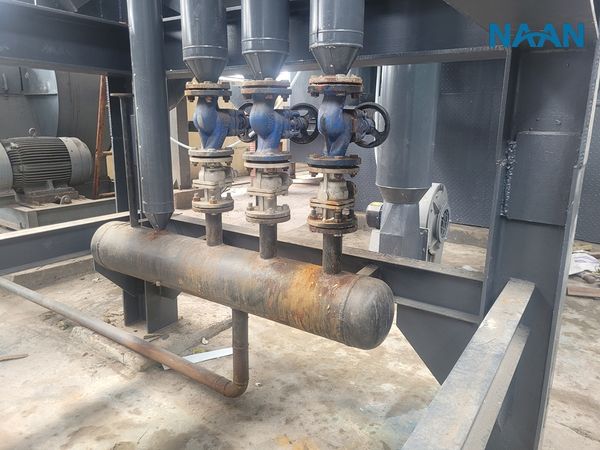How to blow down the boiler effectively
I. Why is it necessary to regularly blow down the boiler?
1.1. Concept of blowdown boiler
To control the water quality in the boiler to meet regulatory standards and temporarily maintain impurities in the boiler water To a certain extent, it is necessary to continuously remove boiler water containing large amounts of salt and alkali and water residue, thick sludge or loose agglomerates in the boiler. This process is called blowdown boiler. Blowdown is an important part of boiler water quality management, therefore, everyone needs to take blowdown seriously to achieve the goals of safe operation, reduced consumption and energy saving for boiler systems.

Blowdown valve and collector system
1.2. Method of draining water
Draining water of a boiler can be divided into: periodic flushing and continuous flushing.
Periodic flushing:
- Also called intermittent flushing or bottom flushing, its function is to remove water residue and soft agglomerates created after treatment with Phosphate is piled up at the bottom of the boiler. Periodic water discharge only takes place for a short time but has a very strong ability to remove residue in the boiler.
- The periodic water discharge door is usually located under the lower part of the furnace body and the manifold , periodic flushing should be carried out when the water level in the boiler is high, the load is light or the firing state is light. On small boilers, there is usually only a periodic water discharge.
Continuous water discharge:
- And called surface water discharge, is a continuous process from the water surface of the tank to get the highest concentration of boiler water. Its function is to reduce the amount of salt and alkalinity in the boiler water, preventing the boiler from being affected by too high a salt concentration that affects steam quality.
- Continuous water discharge pipe mouth is usually Installed at about 80-100mm below the normal water level of the water tank (also known as position "0"). Because the boiler water gradually concentrates due to continuous evaporation, the salt concentration is highest near the water surface. Therefore, the continuous water discharge mouth should be installed in the area with the highest salt concentration in the boiler water, to continuously discharge high concentration water, supplemented with clean water, thereby improving the boiler water quality. steam, the typical discharge rate is about 1% of the evaporation amount.
II. Periodic water discharge device at the bottom of the boiler
Water discharge device includes a short water discharge pipe, water discharge valve and water discharge pipe in the boiler body .
Drain valve should use gate valve or ball valve. The standard diameter of the water discharge valve is DN25~50. For boilers with rated evaporation volume ≥1t/h or working pressure ≥0.7Mpa, the water discharge pipe should be installed with two water discharge valves in series.
The traditional design is a slow release valve (using a globe valve) + a quick release valve (high temperature ball valve), but as we know, the seal is soft PTFE in ball valves, which often have to endure temperatures higher than 140 degrees, are susceptible to aging and deformation, which in turn increases wear and eventually leads to valve leakage. Very short service life. The tight slot of the globe valve can easily contain impurities, the globe valve cannot close and leads to leakage. This is a common problem and headache in factories today!
When flushing, the flush valve is subjected to high pressure of hot liquid and abrasion by residue, after stopping When flushed, they will gradually cool to room temperature. To improve harsh working conditions such as abrasion and corrosion of residue, vibration, and thermal impact, series drain valves need to have a certain operating order:
- when discharging water, first open valve 1 (slow valve), then open valve 2 (fast valve);
- when stopping discharging, first close valve 2, then close valve 1 .
Valve 1 is a slow valve and must be able to resist alkaline corrosion of boiler water; Valve 2 is a quick valve, which must meet the requirements for timing and flushing action.
III. Method of periodically draining water at the bottom of the boiler:
Operators need to take safety precautions, only draining water when the boiler load is low, preventing prevents failure of high heat contact surfaces under high load conditions; Adjust the water level in the furnace body to a high level, then drain the water.
3.1. Instructions for flushing:
According to the principle of "flush often, flush little, evenly"
① Flush often water
Meaning that the number of flushes must be a bit more, especially when using bottom flush to remove water residue, flushing multiple times in a short period of time will be more effective than with one large flush over a long period of time;
② Low Flushing water
Just perform regular flushing, and low flushing will automatically be achieved water, meaning the amount of water released each time must be small. This not only ensures zero shots affects steam supply, but also keeps boiler water quality always controlled within the standard range without causing large fluctuations;
③ Uniform water discharge
That means trying to make the time interval between each water discharge almost the same, so that the boiler water quality always remains stable.
Note: Discharging water is prohibited. under high load of the boiler; It is forbidden to discharge water below the low water level in the boiler body.

Blowdown valve system and collector pipe discharged to the outside
a. Order of operation:
When draining water, first open valve 1 (slow valve), then open valve 2 (fast valve); When stopping water discharge, first close valve 2, then close valve 1.
Water discharge time: Water discharge must be done briefly and intermittently, each discharge of each valve group Flushing usually only takes 20-30 seconds. When draining, the water drain valve must open immediately then close, close immediately then open, repeat 2-3 times. This helps attract debris to quickly flow into the drain pipe and create water waves to enhance flushing performance.
The number of times and duration of daily flushing can be decided based on on measuring the electrical conductivity of boiler water.
b. It is also necessary to drain water periodically when starting the boiler
At this time, the water released is part of the water at the bottom of the circulation, not only making the impurities are removed to ensure boiler water quality, but also enhance the heat transfer quality of circulations with weak heat, prevent local water circulation delays, making all surfaces The metal surface of the water circulation system is expanded evenly, minimizing the temperature difference between the upper and lower surfaces of the water tank.
IV. Boiler water quality
Because boiler water contains rust and water residues that have aggregated after being treated with chemicals and are deposited in bottom of the water cycle, over time, will lead to a decrease in boiler water quality, which can be reflected in conductivity and pH measuring devices installed in the drain box.
Add Na3PO4 into the water tank to treat boiler water, making Ca2+, Mg2+ and other substances in the boiler water form non-cohesive water residue, which is then drained out.
V. The purpose of flushing
Is to remove rust and water residue that has accumulated after being treated with chemicals, deposited at the bottom of the water cycle , through periodic or continuous flushing, causes these deposited water residues to be removed, providing boiler water quality. Make sure that the pH of the boiler water is between 9.4-10.5, and the electrical conductivity is below 200us/cm.
VI. Reusing heat from water discharge
The water discharge rate of a boiler is usually 3~10% of the boiler's capacity, to reuse this indispensable heat. , it is often necessary to install periodic and continuous flushing tanks in the boiler room. Divide the depressurized water into separate steam and water for use. Steam is often fed into an above-ground oxygen removal device to de-oxygenate the water, while dirty water after heat exchange is cooled and then safely discharged into the gutter.

